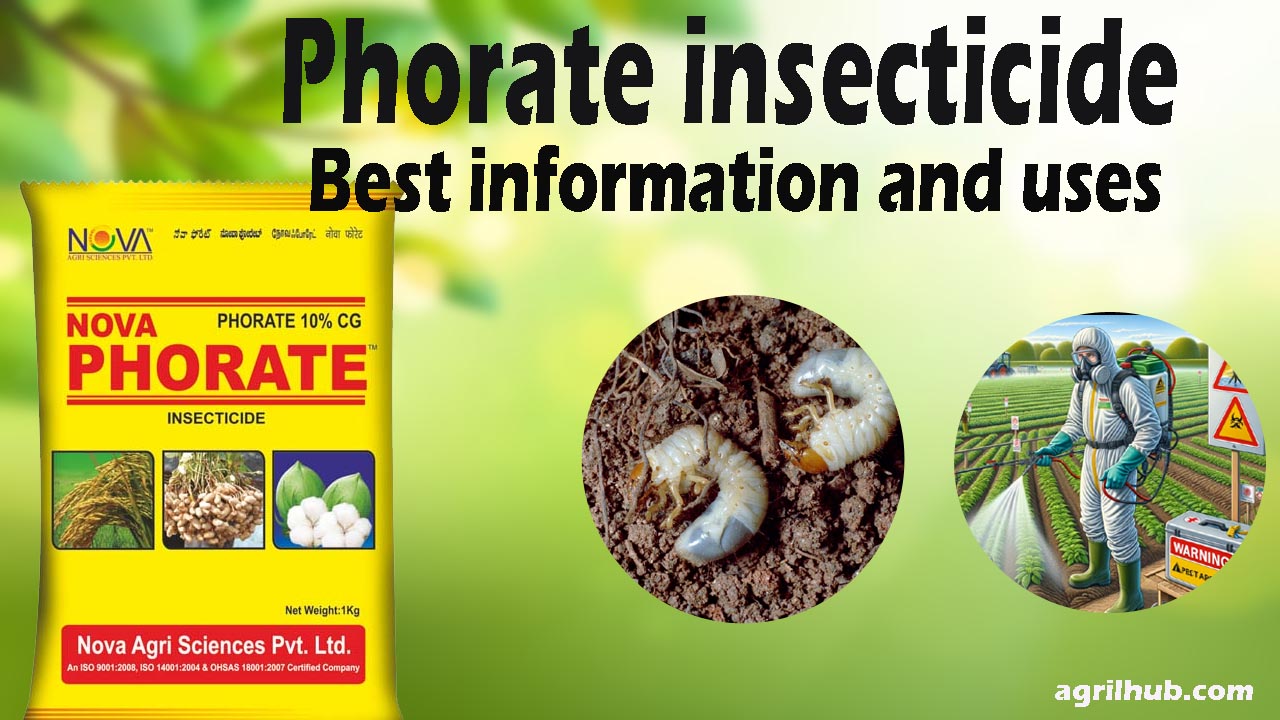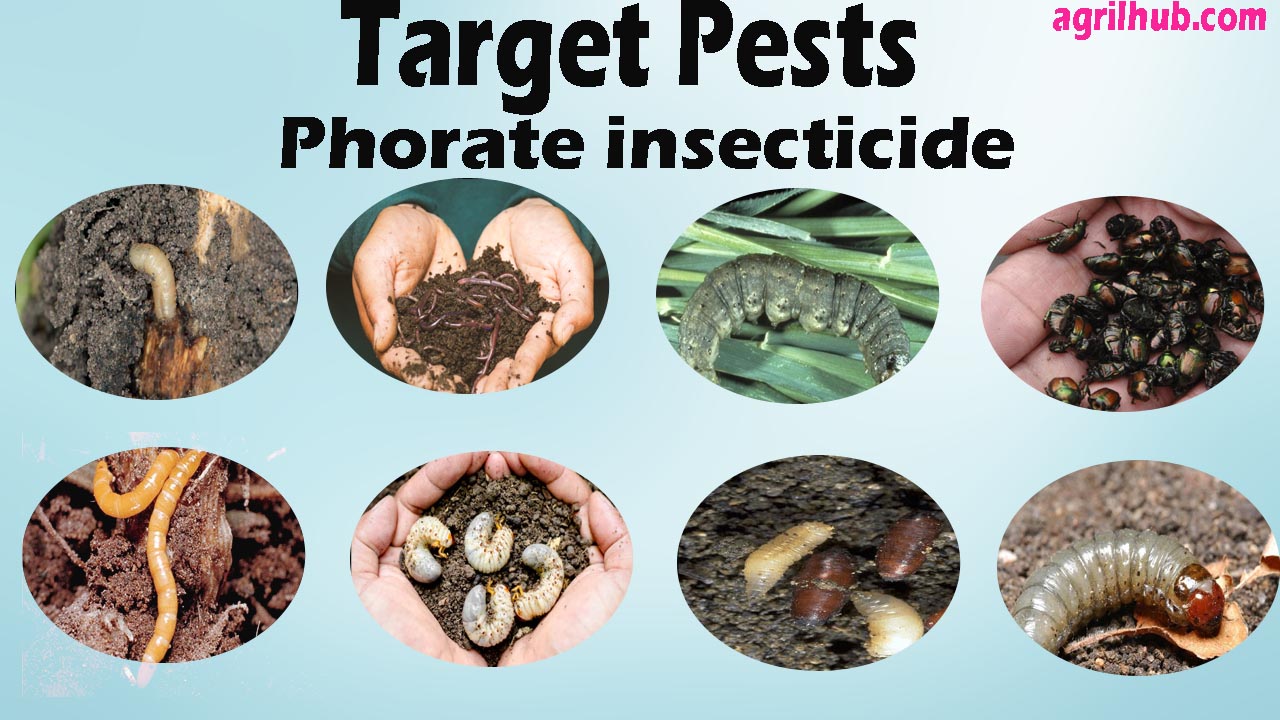Hello everyone, In this article we will discuss Phorate Insecticide and its important factors such as its chemical composition, trade name, mode of action or mechanism, recommendation, against which insect it works, and special precautions for spraying it.
Phorate is a systemic insecticide that belongs to the neonicotinoid class. It damage the nervous system of insects, which may result in paralysis and death. This insecticide is majorly used in the agricultural sector to protect the crops like cotton, cereals and vegetables.

Read also- Cypermethrin Insecticide: Best Information & uses in 2024
What is Chemical composition of Phorate ?
- Chemical formula- C7H8O2PS3
- Molecule weight- approximately 246.29 g/mol
- Chemical Name-O,O-Diethyl S-(4-methylthio) phenyl phosphorodithioate
- common Name- Phorate
(i) Chemical Element
- Carbon (C): 7 atoms × 12.01 g/mol = 84.07 g/mol
- Hydrogen (H): 8 atoms × 1.01 g/mol = 8.08 g/mol
- Oxygen (O): 2 atoms × 16.00 g/mol = 32.00 g/mol
- Phosphorus (P): 1 atom × 30.97 g/mol = 30.97 g/mol
- Sulfur (S): 3 atoms × 32.07 g/mol = 96.21 g/mol
(ii) Chemical structure of phorate
Phorate contains one phosphate atom, it is center of all, which have two ethyl groups bound to one phenyl groups and two sulfur atom.
What is the formulation of Phorate ?
(i) Granule Formulation of phorate
This is the solid part which spread in the soil and it is mixed by plowing so that the height of the fort is not visible. In Some cases, we keep Phorate there for the paste living in any hole or cracks. The concentration of phorate available in phorate granule is generally 10-15%.
(ii) Emulsifiable Concentration
It is a thick solution and before using it, water is added whic h reduces it concentration than use it. The concentration of phorate available in phorate emulsifiable concentration 20 – 30%.
(iii) Phorate Seed Treatment
For seed treatment, we apply phorate directly on the seed, which prevent them form emerging from soil. The concentration of phorate available in phorate is generally 10-20%,
(iv) Tablets and pellets formulation
It is like a granule but compare to granule its shape is different and hence the material release rate also different, we use it soil also.
Phorate Uses
(i) Insect Control
(a) Soil pest
Phorate destroy the insect or their larvae that live in the soil and eaten roots, in this we use phorate in the form of granules.
(b) Leaf eating Insect
Phorate is also used to control leaf eating insects like leaf hopper. in this used phorate in from of spray methods.
(ii) Nematicide
phorate is also used to control parasitic nematodes which are very small and they bits the root of plant to get their food.
(iii) Crop
(a) Vegetable
Insect and Nematode living in the soil cause and lot of damage our vegetable like carrot, potato etc. to avoid this damage, we should apply phorate insecticide.
(b) Grains
Phorate destroy the insect or their larvae that live in the soil and eaten roots, Ex- corn, wheat etc.
(c) Fruits and Nut
Phorate is also use to protect us from insect that destroy fruit and nuts
(iv) Seed Treatment
Before sowing the seeds we treat the seed with phorate so that the insects that appear after sowing cannot cause any harm.
Most popular trade name of phorate
(i) Thimate
(ii) Phorate 10G
(iii) Drexel Phorate 10G
(iv) Phorate granule
(v) Temik
Phorate Target Paste

1. Rootworms
Root warm are found in the soil in the form of larvae and before becoming pupae they take their food form the root of plants and it cause great damage to the root of the corps, the effect of which is visible on the entire crops. The name of some rootworms paste on given below which we can control with phorate.
- Western Corn Rootworm- Western corn root worm feeds on the roots of corn, causing the corn to collapse due to wind and reduce yield.
- Northern Corn Rootworm- Northern corn Rootworm also attacks corn roots like western corn rootworm.
- Southern Corn Rootworm- Southern Corn Rootworm also attacks corn roots like western corn rootworm.
- Mexican Bean Beetle- Mexican bean beetle eats the roots of Been plants and attack leguminous plant.
2. White Grubs
White grubs is white and C- shape, they are found in the soil in the form of larvae and before becoming pupae they take their food form the root of plants and it cause great damage to the root of the corps, the effect of which is visible on the entire crops. And adult insect attack the leaves, flowers and stem. The name of some white grubs paste on given below which we can control with Phorate.
- European Chafer- it is found in north America and other regions. Its larvae also eat the root of horticulture plant.
- Japanese Beetle- It is green in color and about 1.5 inches long. They cut leaf, flower and the stem between the plant and their larvae eat the root of the crops.
- Asiatic Garden Beetle-It is brown in color and about 1.5 inches long. They cut leaf, flower and the stem between the plant and their larvae eat the root of the crops and it also harm some vegetable. Ex- Potato, Carrots etc.
- May Beetle- It is Red-brown in color and about 1 inches long. They cut leaf, flower and the stem between the plant and their larvae eat the root of the crops. It can survive long summer.
3. Cutworms
They are notorious for their destructive feeding habits, particularly their tendency to cut off young plants and seedlings at or near the soil surface. The name of some cutworms paste on given below which we can control with Phorate.
- Black Cutworm- They often feed at night and cut down young plant or seedlings stage.
- Variegated Cutworm- They often feed at night and feed on ornamental corps.
- Army Cutworm- They are found in large numbers and cause damage to our crop some crop like corn, vegetables etc.
- Granulate Cutworm- They feed at night and eat the stems and root of plant.
4. Wireworms
Wireworms are found in the soil in the form of larvae and before becoming pupae they take their food form the root of plants and it cause great damage to the root of the corps, the effect of which is visible on the entire crops. The name of some Wireworms paste on given below which we can control with phorate
- Various Species
- Pale Wireworm
- Common Wireworm
5. Other Soil-Dwelling Pests:
- Symphylids- They eaten root of crops. It is found in the form of nimbs.
- Nematodes- They eaten root of crops. they are verry verry small.
6. Various Soil-Dwelling Beetles and Insects:
- Root Weevils- Root weevils damage the root of the plant and hinder its growth/
- Seed Corn Maggot- it is type of paste that effect corn seeds.
Phorate application method
(i) Soil Application
In soil Application, we use phorate in the form of granule and after using it, we plow it 2-3 inches with a machine, which they goes into the soil and control paste.
(ii) Seed treatment
Before sowing the seeds we treat the seed with phorate so that the insects that appear after sowing cannot cause any harm.
(iii) Furrow Application
In this, we mix phorate near the drain where the seed on sown, due to which the effect of the pesticide near germinated seeds, thus preventing them form growing.
(iv) Broadcasting
In this method, phorate is spread over the soil in large area and plowing is use to move the phorate in to the soil. this is the main thing that we do before sowing.
(v) Post planting treatment
In this method we use phorate after planting, we apply phorate in the same way to kill any paste that comes in contact with it.
Personal safety of phorate in agriculture

-
Read label-
We should carefully read the guidance written on the packet of Phorate insecticide. This guidance is written by its manufacturer.
-
Leave Area-
We should should leave area for 24-48 hours after applying this Phorate Insecticides.
-
Wear protective clothes
We should wear safety clothes for our personal safety ex- Protective clothe, goggles, gloves, protective footwear, long pant and mask etc.
-
Store properly
We should keep the insecticide at a safe place where no animal or children can reach and it use in a well banded bag where no air can enter. When air gets inside the Phorate insecticide, it may spoil.
-
First Aid
We should know first aid before the any incident occurs to Phorate insecticide Ex-
(i) Inhalation
After applying insecticide we should go to fresh air. other wise you may feet suffocation.
(ii) Avoid Skin Contact
After applying, we should wash our hands and feet thoroughly with soap and water.
(iii) Avoid Eye contact
After applying, we should wash our eye thoroughly with water for about 15 minutes,
